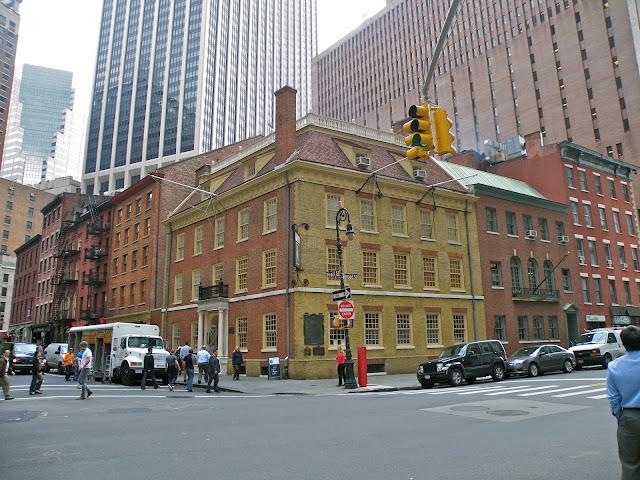26th September 2012. We took the subway to the East Side and found the Tenement Museum in Orchard Street. The museum has some of the original tenements to show off and to see these we needed to book on a tour. We were lucky to be able to book on the tour which showed tenements occupied by Irish immigrants. The tenements are small, about two or three rooms at the most, a little like the back to backs in Birmingham or the Glasgow tenements. With a sort of front room, interior room with no windows and sort of large cupboard, also with no windows at the back. Old paint and plaster was peeling off the walls, the laths showed through the ceiling, there was one dull light for the entire tenement. It was an eye opener, how these poor Irish immigrants lived. The tenement was at the top of the block and reached by the fire escape, although there was also a rickety internal stair case. At the bottom of the block, in the yard was a bank of four
 |
Lavatories/toilets/washrooms(!?)/bathrooms(!?) or, perhaps more accurately
New York tenement water closets, Tenement Museum, East Side. |
earth closets (toilets or as they say in New York washrooms, but how you could wash in them I can't imagine) to serve for the entire block. We were invited to try the weight of a bucket, filled with pebbles, which was the weight of the water from the stand-pipe the inhabitants would have to carry up all the stairs every day, three or four time a day. Our guide or "educator" as they call them, took us up four flights of the fire escape to the top and it was the dimly lit tenement with peeling paint and crumbling plaster walls exposed laths on the ceilings which we entered first. There were seats in the only room with the window and she explained about the Irish potato famine and how they came over the Atlantic to Ellis Ireland, to be admitted into the United States for a new life, but how the Irish mainly only knew rural life or manual labour to make a living in New York and there fore took jobs like "peddler" which is New York for "salesman" and builders, whereas in England a "peddler" is a bit of a vagrant who might also sell things. There would be very little money coming in and life was hard in that tiny tenement, so hard that their baby girl died. Some blocks kept a cow in the basement in such squalid condition there was only unhealthy "blue milk" available. We were played some New York/Irish music, which was so good, we brought back a CD. We were shown cartoons from one of the New York Newspapers, which showed tall German immigrants gossiping over the washing and the Irish immigrants cruely lampooned with monkey faces. Our "educator" gave us a clear picture of the hard life for the family which prospered better once they moved away from the tenement. We were shown birth and death certificates for the little infant and a picture of her sister, who was born in better circumstances and survived into old age. The tenements were so notorious that when better tenements were being built New Yorkers looked for a better name for them. They found it. Rather than the English 'flats' they took 'apartments' from the French and that is how they are called today. I wish I could give you an impression of that dark-one window, cupboard-like three room tenement. If you go to New York, visit the museum, take a tour and see for yourselves. After the visit we took the subway to 49th Street and after asking a newspaper salesman the way to the port... he was really friendly and a bit surprised to find out we intended to walk, but having given us directions, he invited us to donate to his local charity, which we were pleased to do. The port was at the end of several blocks down a long street. It was along this street I smelt Havana cigars at the limousine garage and saw the long butt end of one partially unfurled on the sidewalk.
It was such a relief to reach Arcadia and take our shoes off. Our throbbing feet were rested overnight, ready for the next day. That evening we had an entertainment. Three young men from New York came on board and gave a great selection of songs, accompanied by the Arcadia Orchestra in the Paladium theatre. We had an evening meal in the restaurant, efficiently served by Godwin and Clint our friendly waiters. If I bothered to dig out the menu, I could tell you what we ate. Save that for another day, suffice it to say, my first day and evening in New York was a wonderful experience. I hope I have been able to convey, just how wonderful to some of you.





















